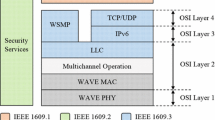Abstract
Vehicles in Intelligent Transportation System (ITS) can communicate with other vehicles or roadside unit (RSU) within a specific area. In ITS, different services have different requirements of Quality of Service (QoS). For delay-tolerant services, such as FTP and Email, a longtime fairness should be guaranteed, which means vehicles with different speeds should have the same chance to communicate with RSU. While for real-time services, such as voice and video, a low average delay should be achieved. Based on original DCF scheme, much modification work has been done to achieve better QoS for mixed services, but fail to consider the unfairness problem brought by mobility. In this paper, we study the performance of 802.11p MAC scheme under high- speed mobility conditions and build a Mixed-Service-Mobility model to analyze the interaction among different services. By adjusting the minimum contention window size of 802.11p MAC scheme according to different speeds, we succeed in providing a balance between the longtime fairness of delay-tolerant services and the average delay of real-time services. The proposed analytical model is validated against simulation results to demonstrate its accuracy and effectiveness.









Similar content being viewed by others
References
Zeadally, S., Ray, H., Yuh-Shyan, C., Angela, I., & Aamir, H. (2010). Vehicular ad hoc networks (VANETS): Status, results, and challenges. Telecommunication Systems, 50, 217–241. doi:10.1007/s11235-010-9400-5.
Du, Y., Zhang, L., Feng, Y., Ren, Z., & Wang, Z. (2010). Performance analysis and enhancement of IEEE 802.11p/1609 protocol family in vehicular environments. In Proceedings of the 13th international IEEE conference on intelligent transportation systems (pp. 19–22).
Karamad, E., & Ashtiani, F. (2008). A modified 802.11-based MAC scheme to assure fair access for vehicle-to-roadside communications. Computer Communication, 31, 2898–2906.
Alasmary, W., & Zhuang, W. (2010). Mobility impact in IEEE 802.11p infrastructureless vehicular networks. Ad Hoc Network, 10, 222–230. doi:10.1016/j.adhoc.2010.06.006.
Baldwin, R. O., Davis IV, N. J., & Midkiff, S. F. (1999). A real-time medium access control protocol for ad hoc wireless local area networks. Mobile Computing and Communications Review, 3(2), 20–27.
Hamidian, A., & Körner, U. (2008). Extending EDCA with distributed resource reservation for QoS guarantees. Telecommunication Systems, 39(3–4), 187–194. doi:10.1007/s11235-008-9124-y.
Villalón, J., Micó, F., Cuenca, P., & Orozco-Barbosa, L. (2010). Multiservice unicast/multicast communications over IEEE 802.11e networks. Telecommunication Systems, 43, 59–72. doi:10.1007/s11235-009-9193-6.
Mangold, S., Choi, S., May, P., Klein, O., Hiertz, G. & Stibor, L. (2002). IEEE 802.11e wireless LAN for quality of service. In Proceedings of the European wireless, Florence, Italy.
Sobrinho, J. L., & Krishnakumar, A. S. (1999). Quality-of-service in ad hoc carrier sense multiple access wireless networks. IEEE Journal on Selected Areas in Communications, 17(8), 1353–1368.
IEEE P802.11.(2010). IEEE standard for information technology–Telecommunications and information exchange between systems–Local and metropolitan area networks–Specific requirements.
Ng, S. C., Zhang, W., Yu, Y., Yang, Y., & Guoqiang, M. (2011). Analysis of access and connectivity probabilities in vehicular relay networks. IEEE Journal on Selected Areas in Communications, 29(1), 140–150.
Wang, Z. & Hassan M. (2009). The throughput-reliability tradeoff in 802.11-based vehicular safety communicates. In IEEE consumer communications and networking conference (pp. 1–5).
Songnan, B. A. I., & Jung, J. I. (2010). Congestion awareness multi-hop broadcasting for safety message dissemination in VANET. IEICE Transactions on Communications, E93–B(12), 3381–3390.
Campolo, C., Vinel, A., & Koucheryavy, Y. (2011). Modeling broadcasting in IEEE 802.11p/WAVE vehicular networks. IEEE Communication Letters, 15(2), 199–201.
Chen, Q., Jiang, D. & Delgrossi, L. (2009). IEEE 1609.4 DSRC multi-channel operations and its implications on vehicle safety communications. In IEEE vehicular networking conference (pp. 1–8).
Misic, J., Badawy, G., & Misic, V. B. (2011). Performance characterization for IEEE 802.11p network with single channel devices. IEEE Transactions on Vehicular Technology, 60, 1775–1787.
Acknowledgments
This work was supported in part by the 111 Project (No. B08004), the major project of Ministry of Industry and Information Technology of the People’s Republic of China (2010ZX03002-006). The authors would like to thank anonymous reviewers for their valuable comments.
Author information
Authors and Affiliations
Corresponding author
Rights and permissions
About this article
Cite this article
Zhang, L., Liu, Y., Wang, Z. et al. Mobility and QoS oriented 802.11p MAC scheme for vehicle-to-infrastructure communications. Telecommun Syst 60, 107–117 (2015). https://doi.org/10.1007/s11235-014-9925-0
Published:
Issue Date:
DOI: https://doi.org/10.1007/s11235-014-9925-0




